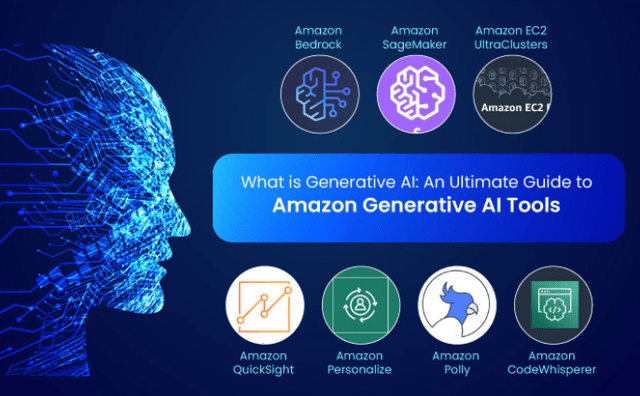dem10
In the rapidly evolving domain of generative AI, Amazon (NASDAQ:AMZN) is positioning itself as a formidable contender, leveraging its cloud infrastructure prowess and strategic alliances. While rivals like Google (GOOG) and Microsoft (MSFT) have made significant strides, Amazon’s unique approach, rooted in its cloud market leadership through AWS and a focus on choice and ease of use, sets it apart in this competitive landscape. While this may not be apparent today as most seem to believe that Amazon is behind in the Gen AI race, we believe the company’s strategy around providing access to a variety of LLM models and its leading cloud market share will eventually position it as the winner in this race.
Timeline of Amazon’s Generative AI Developments
Let’s first recap various developments around around Gen AI as it relates to Amazon and what we can learn from these. We will then go into details around some of these takeaways (in later sections) to evidence our theory of why Amazon comes out ahead in this race.
-
Pre-2022
- Amazon had been developing its large language models (LLMs) for internal use, likely as part of its broader AI and machine learning initiatives within AWS and Alexa.
-
2022
- June 2022: Amazon announced CodeWhisperer at the re:MARS conference. CodeWhisperer is a text-to-code solution similar to GitHub Copilot.
- November 2022: Amazon experienced significant organizational changes with layoffs, which may have influenced its strategic approach to generative AI.
-
2023
- Early 2023: Amazon’s focus on generative AI became more evident. This period likely involved planning and strategizing their approach to leveraging this technology.
- April 14, 2023: Amazon launched Bedrock, a generative AI service, and made CodeWhisperer generally available and free for individual use, marking its direct competition with Microsoft’s OpenAI services and GitHub Copilot.
- August 4, 2023: Amazon’s CEO, Andy Jassy, outlined the company’s comprehensive strategy for generative AI, emphasizing the development of applications and the integration of AI into AWS offerings.
- September 25, 2023: Amazon announced a significant investment of up to $4 billion in Anthropic, a large language model provider, gaining a minority ownership position and solidifying its commitment to generative AI.
- October 28, 2023: Following Amazon’s investment in Anthropic, Google also invested an additional $2 billion in the company, highlighting the competitive nature of the generative AI market.
Key Takeaways
-
Strategic Direction: Amazon’s strategy in generative AI revolves around providing a diverse range of AI models, emphasizing flexibility and choice for AWS customers. The launch of services like Bedrock and the free offering of CodeWhisperer reflect this approach.
-
Cloud Infrastructure Leverage: AWS’s dominance in the cloud market is a significant factor in Amazon’s generative AI strategy. The company aims to use its cloud infrastructure as a platform for deploying AI services and models.
-
Focus on Applications: Much of Amazon’s efforts are geared toward the application layer of generative AI, highlighting its potential in enhancing customer experiences and developing new solutions.
-
Competitive Stance: Amazon’s investments and developments in generative AI are in direct competition with major players like Google and Microsoft, each vying for dominance in this rapidly evolving field.
-
Future Outlook: With Amazon’s continuous investment and strategic partnerships in the generative AI space, it is positioning itself as a key player. Future developments are likely to focus on further integrating AI into its product offerings and enhancing AWS’s capabilities in this domain.
Amazon’s Generative AI Strategy: A Differentiated Approach
Amazon’s strategy in the generative AI space is multifaceted, focusing on providing a broad range of AI models and creating an ecosystem that emphasizes flexibility and accessibility. This strategy is exemplified by the launch of services like Bedrock and CodeWhisperer. Bedrock, in particular, is a testament to Amazon’s commitment to offering a diverse array of AI models. It’s not just about promoting Amazon’s proprietary models; it’s about providing an “everything else” alternative to the AI models hosted by other cloud giants. This approach contrasts with Google’s focus on its own AI models like PaLM and Gemini, and Microsoft’s close ties with OpenAI and its GPT suite.
Moreover, Amazon’s decision to make its CodeWhisperer service free for individual developers is a strategic move that not only challenges the existing models like GitHub Copilot but also speaks to the company’s understanding of the importance of developer engagement in the AI ecosystem.
AWS: The Cloud Market Leader
A key advantage for Amazon in the generative AI race is its leadership in the cloud market through AWS. AWS’s dominance in cloud infrastructure provides Amazon with a vast and diverse customer base, ranging from startups to large enterprises. This extensive reach gives Amazon a unique advantage in rapidly deploying and scaling AI solutions. The deployment of its AI-optimized chips, Trainium and Inferentia, further strengthens its position, offering a cost-effective and efficient alternative to NVIDIA’s GPUs. This move not only enhances AWS’s appeal as a platform for AI development but also positions Amazon favorably in terms of both operational costs and environmental sustainability, an increasingly important consideration in technology infrastructure.
The Convergence of LLM Models and the Importance of Choice
As large language models (LLMs) evolve, we’re likely to see a convergence in their capabilities, as they all utilize similar underlying data sets and machine learning techniques. In this scenario, the winner in the AI race will not necessarily be the one with the most advanced model, but rather the one that offers the most choice and ease of use. Amazon’s strategy, which emphasizes providing a variety of AI models through AWS, positions it strongly in this respect. By not limiting itself to proprietary models and embracing a wide range of AI technologies, Amazon ensures that its customers have the flexibility to choose the best tool for their specific needs.
The Commercialization of Generative AI: The Application Layer
The real commercial potential of generative AI lies in its application layer. Most of the tangible benefits and innovations will emerge from how these AI models are applied in various industries and domains. Amazon, with its diverse range of services and sectors, from e-commerce and entertainment to home automation and cloud services, is uniquely positioned to integrate generative AI into a multitude of products.
In the e-commerce domain, for instance, generative AI can revolutionize personalized shopping experiences, recommendation systems, and customer service. Amazon’s voice assistant, Alexa, is already a household name, and the integration of advanced generative AI could significantly enhance its conversational capabilities and utility. Similarly, in the realm of cloud services, AWS can offer generative AI-driven solutions for data analysis, cybersecurity, and more, providing Amazon’s clients with cutting-edge tools to optimize their operations.
Amazon Products: The Next Frontier for Generative AI
Looking ahead, we can expect to see generative AI incorporated across a range of Amazon products. In Alexa, for instance, generative AI could lead to more natural, context-aware interactions, making the assistant more intuitive and helpful in daily tasks. In Amazon’s e-commerce platform, generative AI could be used to create more personalized shopping experiences, from customized product recommendations to AI-driven customer support that can understand and respond to complex queries more effectively.
AWS itself is likely to be a major beneficiary of these advancements. By offering a suite of tools and services powered by generative AI, AWS can cater to a wide range of business needs, from automated coding assistance to sophisticated data analysis and beyond. This will not only cement AWS’s position as a leading cloud service provider but also drive innovation across various industries that rely on AWS for their computing needs.
Conclusion
In the race to lead in generative AI, Amazon’s strategy of offering a diverse range of AI models, coupled with its dominance in the cloud market through AWS, positions it favorably against competitors like Google and Microsoft. By focusing on choice, ease of use, and the application layer of AI, Amazon is not just participating in the generative AI race; it is reshaping the track. As LLM models converge in capabilities, Amazon’s approach of providing a platform that caters to a wide range of AI technologies and applications could very well be the key to unlocking the full potential of generative AI in the commercial domain. With its vast array of products and services, Amazon is poised to integrate generative AI in ways that could redefine the landscape of technology and business.





![[2401.14673] Generative Expressive Robot Behaviors using Large Language Models [2401.14673] Generative Expressive Robot Behaviors using Large Language Models](https://aigumbo.com/wp-content/uploads/2023/12/arxiv-logo-fb-235x190.png)